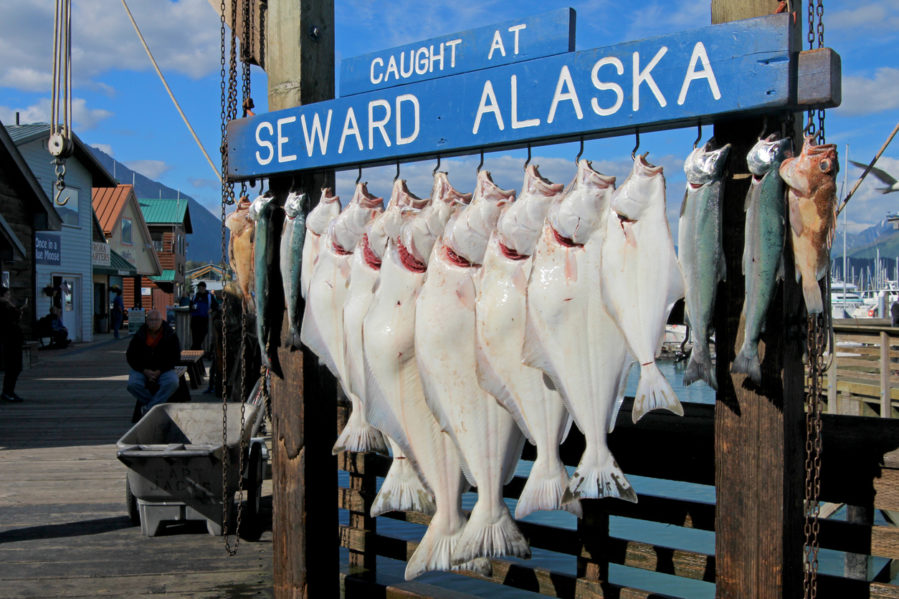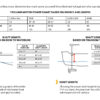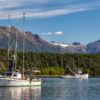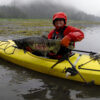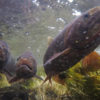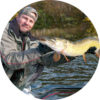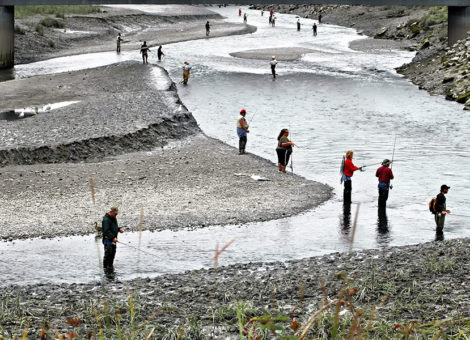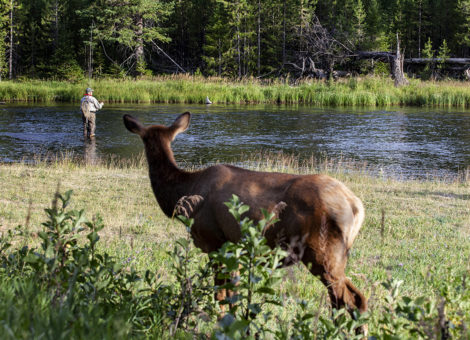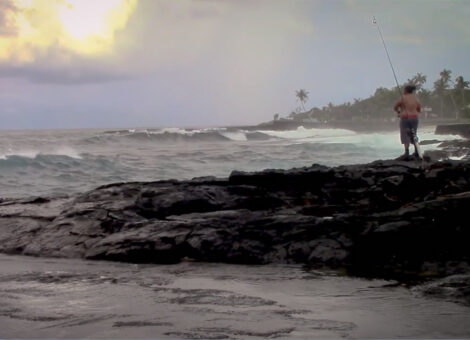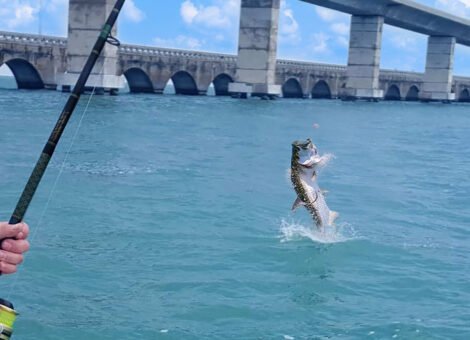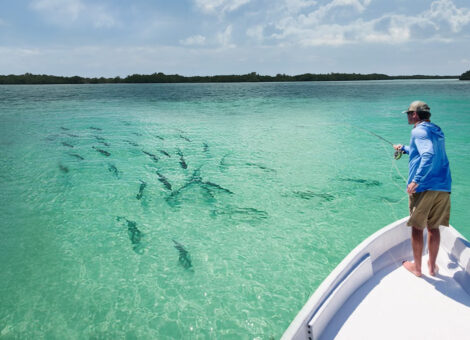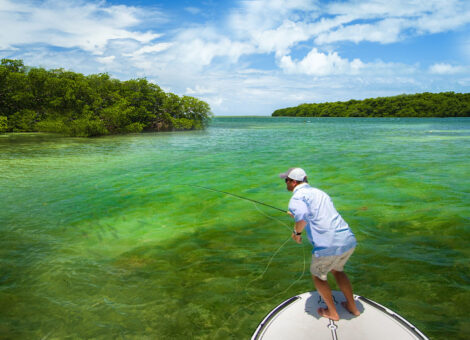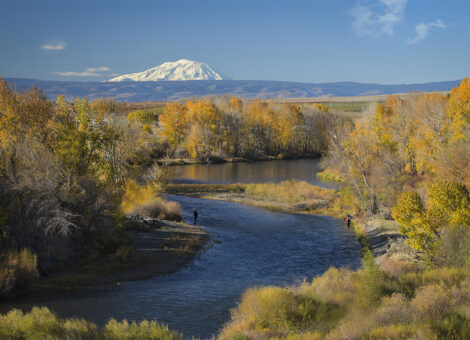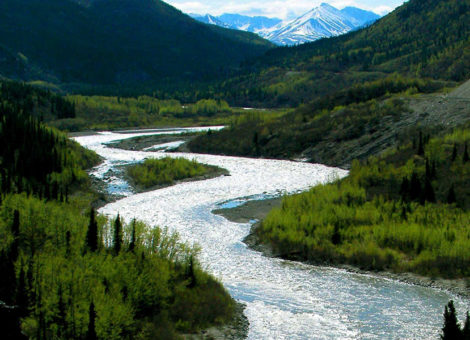Alaska halibut can reach lengths over 8 feet and weight in at over 500 pounds. It’s no wonder large Alaskan halibut are referred to as “barn doors”. The largest Alaska sport-caught halibut on record tipped the scales at 459 pounds (Source: Alaska Department of Fish and Game). While catching a monster halibut in excess of 400 pounds is a rarity, it does happen from time to time. The majority of catches average between 30 and 40 pounds — and catch over 150 pounds is not uncommon.
If you want to catch trophy halibut knowing where to fish is key. While just about every Alaska charter boat captain has a few hot spots for catching halibut, there are certain locations that usually produce better than others. Some of the best locations for halibut fishing include Seward, Whittier, Homer and Ketchikan Alaska. But before you get caught up in identifying the right place to fish, make sure you’re hitting halibut at the right time of day, at the right tide, and during the right season.
Typically, the best time of day for halibut fishing is is just before, during, and after slack tide, when water currents are weakest and it’s easier to keep the bait on the bottom. Regardless of where you choose to cast your line, these hours produce the highest catch rate for halibut. The best season for halibut fishing is mid-May to mid-September. Halibut tend to head to deeper over-wintering and spawning areas during the colder months.
Some anglers believe that the Pacific halibut of Alaska can only be caught near the bottom. The truth is, halibut can be found wherever their food is, and sometimes are found in water column, or near the surface. Using depth finder to locate schools of fish, and fishing that zone is an effective way to find hungry halibut.
Where to Go
Several of the top spots for Alaska halibut fishing are found near Anchorage, while others are more remote and only accessible by boat or plane. The following guide will introduce you to the top places to fish for halibut throughout Alaska.
- Seward
- Homer
- Juneau
- Ninilchik
- Whittier/Prince William Sound
- Port Protection
- Kodiak Island
- Ketchikan
- Sitka
- Yakutat
- Elfin Cove
- Yakobi Island
- Pelican
- Unalaska/Dutch Harbor
Seward
Over the years, Seward Alaska has produced some of the largest halibut catches on record and offers a myriad of productive spots for halibut fishing. The best time of year to fish halibut in Seward is from June through August. Seward may not have quite the same reputation for halibut fishing as Homer, but given it proximity to Anchorage, it tends to be the more popular fishing location.
With Seward as a launching point, anglers will find halibut along the entire coastline of the Kenai Peninsula. A few of the more popular fishing locations accessible from Seward include Fjords National Park, Resurrection Bay, and Prince William Sound. Most serious anglers head east by boat toward Prince William Sound and Montague Island to ancher for halibut fishing.
Pacific halibut in the waters around Seward are usually caught on sandy bottoms and gravel beds at depths of 80 to 500 feet, although they can be found much deeper. Very few halibut are taken from the waters immediate near Seward, but are plentiful throughout Resurrection Bay.
Halibut catches in Resurrection Bay have weighed in at over 350 pounds. However, the majority of halibut found in Resurrection bay average between 20 and 35 pounds. Within Resurrection Bay, Halibut can be harvested from April through October. The waters of Resurrection Bay are often much calmer than other fishing grounds near Seward.
Relatively lighter weights and tackle can be used for halibut fishing out of Seward in Resurrection Bay since this zone experiences less tide fluctuation, tide rip or current than other open Alaskan waters. Lighter sinkers are required, hence lighter rods. Where 4- to 5-pound sinkers are required in open Alaskan waters, anglers can usually get away with 2- to 3-pound sinkers in Resurrection Bay.
The slower currents around Seward Alaska, and in Resurrection Bay, allow anglers to use jigs to catch large halibut. Jigging is effective for catching halibut — and provides a good arm exercise at the same time.
For the intrepid angler, Seward is one of Alaska’s few fishing destinations where fishermen can fish for halibut from kayak. Using specially rigged kayaks, anglers can safely and effectively fish the deeper waters in Resurrection Bay and around Seward where halibut live.
Homer
Sometimes referred to as the Halibut Capitol of the World, Homer is unquestionably one of the best halibut fishing spots in Alaska. Homer is home to a 40-mile-long arm of Cook Inlet, a haven for halibut fishing located on the southwest side of the Kenai Peninsula.
Homer is also the gatewyay to Kachemak Bay, another premier destination for catching monster halibut. Halibut are plentiful throughout the Kachemak Bay from Anchor Point all the way to Homer Spit, and just off of Bluff Point midway between Anchor Point and Homer. However, halibut tend to be slightly more abundant outside Kachemak Bay.
Trophy halibut caught in the waters off Homer can top 7 feet and weigh over 300 pounds. An average full day of halibut fishing in Homer often sees fishing weighing well into the triple digits. Since 100 to 300 pound catches are fairly common, using a stout rod with 80 to 100-pound test line is recommended. A 2 to 3-pound sinker weight is best for keeping bait on the bottom in strong currents.
Most anglers opt to fish for halibut by boat, using either a jig or bottom fishing by drifting or anchoring in one place. If you don’t have access to a boat, and don’t want to book a charter, halibut can also be fished from shore. When fishing from boat, always plan ahead or use an experienced charter company. Rough seas can develop quickly in the waters surrounding Homer.
The best spots to target halibut around Homer are depths of 50 to 200 feet near underwater structures including pinnacles, dropoffs, and kelp beds. As in most of Alaska’s waters, herring is the preferred bait for catching halibut in the waters near Homer, but anglers report success using salmon heads, squid, octopus and an assortment of jigs.
While halibut fishing is best during late summer, the waters surrounding Homer can produce record halibut catches year round. Homer is a 5 hour drive from Anchorage, or a 1 hour trip by plane. Homer is a little more remote than other halibut fishing grounds, but well worth the trip.
Juneau
Located in the Gastineau Channel and the Alaskan panhandle, Juneau is the capital of Alaska. It’s also one of Alaska’s top spots for Halibut fishing. Juneau is not the easiest city to access. You can only get their by boat or plane. However, if experiencing some of Alaska’s best Halibut fishing is a priority, getting there it’s well worth the effort.
Juneau is surrounded by numerous channels, bays, and inlets that provide excellent Halibut fishing conditions and opportunities. Gastineau Channel is typically the first place anxious anglers cast their line and are able to snag a descent size halibut or two. If you’re looking to land a “barn door” Halibut, then fishing Chatham Straight is your best option.
Top halibut fishing spots near Juneau Alaska include Icy Point at the south end of Gastineau Channel; Out Point, Middle Point and Inner Point on the Northeast side of Douglas Island; Young Bay and Point Young in Stephens Passage; the waters surround Grand Island south of Gastineau Channel; the western side of Mansfield Peninsula in Stephens Passage; Auke Bay north of Juneau; and the waters surrounding Shelter Island.
Ninilchik
A two hour drive South East of Seward on the Kenai Peninsula, and 20 minutes North of Hommer, is Ninilchik, a hidden gem for halibut fishing. While small and unknown by the general population, Ninilchik is recognized by experienced anglers as one the best spots to catch giant halibut. Spectacular halibut catches are the norm, not the exception. Ninilchick is located on the Cook Inlet halibut migration grounds.
Halibut are typically found throughout the lower Cook Inlet. However, depending on the time of year, halibut will migrate in- and offshore. April through September the best time to fish halibut in the water off Ninilchik. During the spring and summer, halibut are found feeding in the shallower nearshore waters of Cook Inlet. Come fall, the halibut migrate back to the deeper waters of the Gulf of Alaska.
Beach fishing for halibut in Ninilchik is quite common. In early spring, a few of the best locations near Ninilchik to target halibut from shore include Deep Creek, Whiskey Gulch and Anchor river.
Ninilchik is one the few places in Alaska where anglers can catch 300-plus pound Pacific halibut right off shore. Anglers should use a heavy rod with line tested at 60 to 100 pounds. Sinkers in the 2- to 3-pound range will typically hold bait at the bottom depending on current speed and water depth. To avoid using heavy weights, plan on fishing during slack tide when currents aren’t as strong.
Drift fishing and still fishing while anchored, are the two most popular techniques for targeting halibut in the waters off Ninilchik, though anchoring is often more effective. Anchoring in one spot allows bait to create a scent trail down current that attracts feeding halibut.
Whittier / Prince William Sound
An hour south of Anchorage is the port city of Whittier. Whittier is home to Prince William Sound which offers some of the best halibut fishing grounds in Alaska. Though not as reknown as other fishing destinations such as Seward or Homer, its proximity to Anchorage and Prince William Sound make it a popular destination for halibut anglers.
Whittier is a popular halibut fishery for both shore-based and boat-based anglers. There are several locations along Passage Canal, just off of Whittier, where shore-based anglers can target halibut. If you plan on targeting halibut from shore, try casting off Whittier Harbor or Head of Passage.
The most productive halibut fishing grounds are found two hours or more by boat in Prince William Sound. When fishing by boat, fisherman can access hundreds of hidden coves and remote bays throughout Prince William Sound where halibut are abundant.
Anglers halibut fishing the Prince William Sound out of Whitter often set anchorage overnight in one of the hidden coves and sheltered bays located throughout the Sound. Overnight anchorage can be a safe and effective way of getting within striking distance of some of the best halibut fishing grounds found in Prince William Sound. We recommend picking up a copy of the Cruising Guide to Prince William Sound if you plan on spending any extended time navigating in these waters.
For private boat owners, The Whittier harbor offers over 300 permanent and transient slips, so its possible to leave your boat moored in the harbor the entire summer, making it possible to get on and off of the water quickly.
Because Whittier is situated at the end of a fjord that feeds into the Prince William Sound, strong winds and inclement weather are common. If you’re unfamiliar with the area, or inexperienced navigating Prince William Sound, using a professional charter company is recommended.
Port Protection
If you want to go fishing in Southeast, Alaska and get away from the crowds we recommend fishing Port Protection along the northwestern coast of Prince of Whales Island, on the Alexander Archipelago. Port Protection is just minutes away from some of the best halibut fishing anywhere in Alaska. Port Protection is also known for producing monster salmon, lingcod, and yelloweye rockfish.
While Port Protection is a bit off the beatin path, its waters abound with halibut. It’s worth the trip if you’re an avid angler looking for a bit of an adventure. Halibut can be found just off of of Port Protection port and in all the surrounding waters. About a 40 minute boat trip north west of Port Protection, just across the Sumner Strait, are the virtually untouched waters of Kuiu Island which also team with fish — including monster halibut.
The waters surrounding Port Protection offer hundreds of miles of coves, islands, and points, many of which have never been fished with a rod and reel.
Kodiak Island
Kodiak Island is best known as bear country, but it’s also recognized as one of the best places in the Alaska to catch a giant halibut. The typically catch is 35-40 pounds, but catches over 150 pounds are common. Several fish over 300 pounds are harvested each year by recreational fisherman in the waters surrounding Kodiak Island (Source: Alaska Department of Fish and Game Division of Sport Fish).
The Halibut in the waters surrounding Kodiak Island typically feed at depth up to 200 feet and can weigh in at over 300 pounds. Most prime fishing locations are within a 10-30 minute boat ride from Kodiak Island.
Kiliuda Bay, on Kodiak’s east side, along with Sitkalidak Island, just south of Kodiak’s Old Harbor are popular halibut fishing spots among anglers visiting Kodiak Island. Halibut pulled from Kiliuda Bay tend to be smaller, where the water doesn’t get much deeper than 100 feet in most places.
Kodiak Island is accessible by plane from Anchorage, or Dutch Harbor by boat.
Ketchikan
Halibut are plentiful throughout Southeast Alaska, but they can be difficult to catch if you don’t know where to drop your line. In Southeast Alaska, one of the best places to catch prize Alaskan halibut are the waters surrounding Ketchikan. Ketchikan is just a 1.5 hour plane trip from Seattle. Once in Ketchikan there hundreds of fishing spots access by boat or road (mostly boat) where halibut are abundant. The following are halibut fishing grounds near Ketchikan where halibut can be found.
One of the most effective methods for catching halibut in the waters off Ketchikan is jigging the underwater rockpiles using a jig with cut plugged herring or plastic swimbaits.
The peak period for fishing halibut in Ketchikan is June through August when they are most abundant, but they can also be fished during early spring and late fall with some success.
There are many fishing charters out of Ketchikan that provide guided fishing tours. However, there are some benefits to going at it on your own, if you know what you’re doing. Southeast Alaska—including Ketchikan—has a more liberal bag limit than Southwest Alaska closer to Anchorage. Self guided fishermen can keep up to 2 halibut of any size per day. However, extending from the Canadian border to Cape Spencer in Cross Sound, guided halibut fisherman are limited to 1 halibut per day with size restrictions.
Sitka
Sitka is located southwest of the capital city of Janeau, at the heart of Baranof Island. Sitka provides access to the Gulf of Alaska and some of the most productive halibut fishing grounds in Alaska. Sitka is not known for producing the largest halibut in Alaska. Most halibut catches will range from 20-40 pounds and occasionally over 100 pounds. But what Sitka lacks in pure poundage it makes up for in numbers. Anglers like fishing Sitka because of the shear number of halibut that are found in these waters and the high catch rate.
Halibut catch rates in Sitka improve from late spring through the summer and reach their peak August when halibut are most abundant. Anglers will also see high catch rates through the end of September as halibut begin migrating back to deeper water. A few top offshore fishing areas for halibut include Vitskari Rocks in Sitka Sound, north up the west side of Kruzof Island to Shelikof Bay, around Cape Edgecumbe, Salisbury Sound, Point Amelia, Point Mary, Eagle Rock, the waters surrounding Sealion Island and Kakul Narrows.
While the majority of halibut fishing takes place by boat on the open water, halibut can occasionally be caught along the shoreline. The shoreline along Starrigavan Bay is the most popular roadside location to target halibut, but halibut can also be fished from shore at Halibut Point Recreation Area and Crescent Bay. To reach Starrigavin Bay, travel north from Sitka 7.8 miles to the end of Halibut Point Road at the Starrigavin Campground. To reach Halibut point Recreation Area, travel north from Sitka on Halibut Point Road 4.4 miles. To access Crescent Bay, travel to the Sheldon Jackson College Science Center and park somewhere nearby.
Yakutat
Well known by locals but unfamiliar to most foreigners, the remote town of Yakutat located in Southeast Alaska is a haven for monster halibut. As reported by the Alaska Department of Fish and Game, Yakutat has the “largest average in the state for charter halibut landings.” But to find the big boys you’ll need to travel about 30-45 minutes offshore. Larger halibut typically caught outside of Yakutat Bay. Small specimens are found closer to the shore in shallower waters.
Yakutat fishing grounds typically produce halibut catches between depths 80 – 180 feet, usually on the outerside of coastal waters. Given the minimal current, a 24-32 oz. sinker weight is usually all that is required to get your bait on the bottom. Consequently, halibut retreivals are not nearly as difficult as in some of Alaska’s deeper fishing waters.
Prime season halibut catch rates in Yakutat are approximately 5 hours per fish harvested (Source: Alaska Department of Fish and Game). Fishing for halibut in the deeper waters of the Yakutat bay during the winter months is common (and productive) but can be challenging when conditions turn harsh.
There is a double boat launch in Yakutat Harbor. Boats must travel 20 miles through Monti Bay to reach open waters at the mouth of Yakutat Bay. Alternatively, fisherman can fish among the many islands found throughout the Yakutat Bay.
Yakutat is a little out of the way but well worth the trip if giant halibut are on your agenda.
Elfin Cover
Elfin Cove is another remote, off-the-grid top halibut fishing spot in Southeast Alaska. It is located on the north shore of Chichagof Island. Elfin Cove doesn’t have any roads—only boardwalks. And you won’t find any five star hotels or fine dining. As of the most recent census, Elfin Cove had a population of about 30 year-round inhabitants. There is a small lodge and a few fishing charters, but not much else to speak of — other than big halibut found in its inlets that can fished close to shore. For anglers who make the journey to Elfin Cover, there are also ample opportunities for fly-fishing the streams and rivers for trout, pink salmon, coho salmon and dolly-varden.
Elfin Cove is truly one of Alaska untouched frontiers that provides outstanding halibut fishing and a unique wilderness experience. To arrive at Elfin Cove you’ll need to book an Alaska Seaplanes flight from Juneau. Flights are made daily.
Yakobi Island
Yakobi Island is a little known island in southeastern Alaska located on the Alexandar Archipelago. It is approximately 15 miles southwest of Elfin Cove. Most of the bays and inlets surrounding Yakobi Island provide excellent halibut fishing.
One of the most popular areas to fish halibut on Yaboki Island are the waters of Deer Harbor. This remote bay provides access to some of Alaska’s most productive fishing grounds. Many charter boats from Juneau, Pelican, Gustavus and Elfin Cove travel to Deer Harbor Bay to fish its waters.
In Deer Harbor, fisherman can catch just about anything — including halibut. Deer Harbor bay has several areas known as “chicken patches”, where halibut are plentiful but small. While monster females are rare here, the smaller halibut in the 20 to 30 pound range tend to be better eating and produce higher quality, softer fillets that lack the strong flavor common in larger halibut. If you’re looking to pack your freezer with high quality halibut, you can’t beat Deer Harbor.
While halibut are typically bottom feeders congregating on sandy or muddy patches, the halibut in this area can be found anywhere, including gravel and mud bottoms, rocky terrain, atop pinnacles, and steep side-hills.
One of the biggest benefits of fishing for halibut off Yakobi Island and the surrounding areas, is that you rarely bump into other fishermen.
Pelican
The town of Pelican, Alaska is located 15 miles due south of Elfin Cove and 10 miles east of Yakobi Island. Pelican, Alaska and it’s surrounding waters provide excellent halibut fishing. The town of Pelican lives by a motto, “Closest to the Fish” — and this couldn’t be more true. Pelican is situated on the Gulf of Alaska where migrating fish are moving further inland. Not only is a prize catch just a stone throw away, but you’re getting access to fish before they make it inland where the fishing pressure is greater.
Halibut in these waters are abundant, as are just about every other popular game fish including all five species of salmon, rockfish, steelhead lingcod, Yellow eye and Dolly Varden. The halibut hear are not only more abundant but are typically larger than those caught further inland. Where other locations in Alaska provide a 2-3 week optimal window for catching halibut, Pelican provides a full 4-month window of prime halibut fishing season.
Unalaska/Dutch Harbor
Dutch Harbor is a major port on Amaknak Island located in the Aleutian Islands approximately 900 miles southwest of Anchorage. It is a commercial fishing mecca. It is consistenty the nation’s top fishing port by volume of seafood harvested. While this port is primarily known for commercial fishing, there are plenty of opportunities for recreational anglers who want to snag a 200-lb halibut. Halibut are plentiful in the waters surrounding Dutch Harbor and can be fished close to shore. The main access to Dutch Harbor is the Marine Highway. It can also be accessed by plane.
Unalaska Island — as it is referred to — is the southern portion of the Amaknak Island. Giant halibut can be found all along both the Bering Sea and Gulf of Alaska sides of Unalaska. Unalaska Island holds the current 459 pound world record for the largest recreationally caught halibut. There are several charters that provide anglers with access to some of the best known halibut fishing grounds in the waters off Unalaska.


